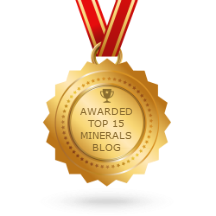It’s remarkable to consider that in the mid-19th century, global annual copper production was only about 60,000 tonnes, compared with roughly 24 million tonnes today. In the early 19th century, Cornwall and Devon in the UK were the world’s leading copper producers. By 1850, however, Cornish mines were in decline. Although still significant by 1860, Chile had overtaken them as the dominant supplier, with the USA emerging as a major producer and eventually surpassing Chile by the late 19th century.
The ores from these early producers were exceptionally high grade, typically between 5-15% Cu. Any necessary upgrading could be achieved by simple hand sorting or by basic ore-dressing methods such as jigs, buddles, and round frames, techniques commonly employed in Cornish tin mining.
 |
Remains of buddles at the Botallack mines, Cornwall |
Chile’s copper boom (1840s-1870s) relied on rich oxide ores, malachite, azurite, and chrysocolla, and production peaked mid-century. By the 1880s and 1890s, however, many of these oxide deposits were exhausted. The remaining resources were low-grade sulfides (mainly chalcopyrite) hosted in large porphyry systems. With 19th-century technology, these were uneconomic: grades were often below 2% Cu, far too low for traditional methods. Consequently, Chile lost its leading position to the United States (notably Michigan and later Butte, Montana) by the late 1800s.
As global demand for copper surged, driven by the electrification of society, the invention of froth flotation around 1905 revolutionised low-grade sulfide mining. Finely disseminated chalcopyrite could now be concentrated to 20-30% Cu, making vast porphyry deposits commercially viable. This technological breakthrough resolved what had seemed an existential problem for the mining industry, allowing Chile to once again supply growing industrial and electrical demand for copper - a position it retains to this day.
From the early 20th century onward, flotation dominated mineral processing, relegating gravity separation to a minor role. It remained vital, however, for certain ores such as tin, and innovations like the Wilfley Shaking Table, still widely used, rendered older devices like Frue vanners obsolete. A resurgence came in the 1970s with the advent of high-capacity gravity separators such as Reichert Cones and spirals, and more importantly, enhanced gravity machines including the Knelson and Falcon concentrators.
Magnetic separation has been part of mineral processing since the late 19th century, but the 20th century brought major advances that transformed it from a niche technique into a standard tool for ore beneficiation. The development of stronger permanent magnet materials enabled compact, reliable drum separators without relying solely on electromagnets. Applications expanded beyond magnetite to paramagnetic iron ores such as hematite and limonite, thanks to finer grinding and high-intensity magnetic separation (HIMS). Further progress in the 1960s and 1970s saw the advent of wet high-intensity magnetic separation (WHIMS) for slimes and finely disseminated ores.
One of the most significant WHIMS developments was the Jones Separator, the first truly practical, high-capacity machine of its kind.
.png) |
| The Jones Separator (a) Plan View b (top view) |
The concept originated with Dr. George Jones, head of engineering at the Camborne School of Mines, who in the late 1950s and early 1960s sought ways to apply strong magnetic fields to weakly magnetic minerals like hematite and wolframite. His innovative rotating carousel design became the foundation of the Jones Separator. Assisting him was a talented mining student, who worked on the prototype for his final-year project. His name was Richard Mozley.
Richard Mozley went on to become one of Cornwall’s most prolific inventors, pioneering hydrocyclones for ultrafine desliming and developing a range of commercial gravity separators. His most renowned invention was the Multi-Gravity Separator (MGS), designed to compete with other enhanced gravity machines such as the Knelson, Falcon, and Kelsey Jig.
Richard Mozley died in 1995, but he would surely have been astonished by the latest evolution of his creation: the C910 MGS, the world’s largest gravity concentrator. Designed specifically for bulk commodities such as iron ore and chromite, it enables the recovery of ultrafine minerals often lost to tailings.
 |
Gravity Mining Directors Colin Colino, Treve Mildren and David Mildren
at the launch of the C910 MGS earlier this year |
We will hear more about this remarkable device at Physical Separation ’26, to be held in Cape Town next April. Dr. Kristian Waters, Associate Professor and Chair of the Department of Mining and Materials Engineering at McGill University, Canada, will deliver a keynote lecture highlighting the renewed importance of physical separations. Enhanced gravity concentrators, along with emerging technologies such as the Reflux Classifier and the new MGS, are at the forefront of this revival. This trend aligns with the industry’s growing focus on responsible energy usage, particularly efforts to reduce comminution energy by rejecting barren particles before grinding, through ore sorting.
Kristian will illustrate how sensor-based ore sorting effectively revives the concept of the human sorter of a century ago, marking a true resurgence in the value of physical separations. It is fitting that this conference is supported by two global leaders in this field: TOMRA and Steinert.
If you would like to submit an abstract to Physical Separation '26, or to Mineral Processing '26 which follows it, the deadline for abstracts is October 31st.
#PhysicalSeparation26























.png)























.jpeg)

















